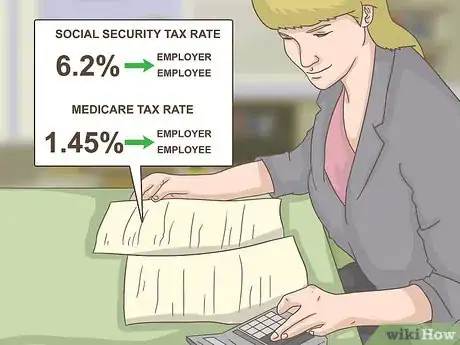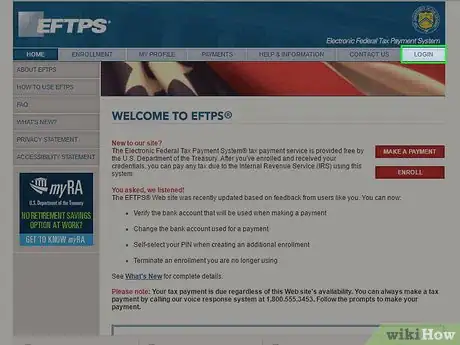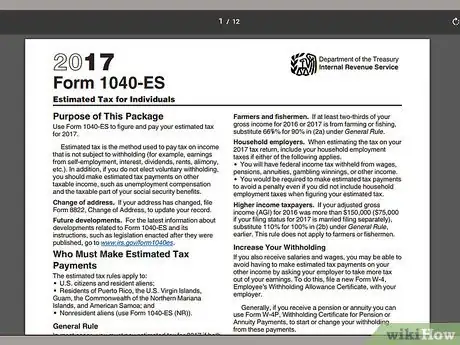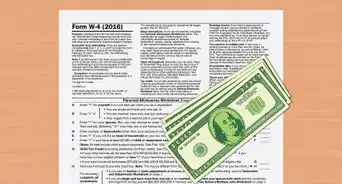This article was co-authored by Cassandra Lenfert, CPA, CFP®. Cassandra Lenfert is a Certified Public Accountant (CPA) and a Certified Financial Planner (CFP) in Colorado. She advises clients nationwide through her tax firm, Cassandra Lenfert, CPA, LLC. With over 15 years of tax, accounting, and personal finance experience, Cassandra specializes in working with individuals and small businesses on proactive tax planning to help them keep more money to reach their goals. She received her BA in Accounting from the University of Southern Indiana in 2006.
There are 8 references cited in this article, which can be found at the bottom of the page.
This article has been viewed 27,458 times.
Employers must withhold certain taxes from their employees’ wages and then deposit them with either the federal or state government. These are called “payroll taxes.” Payroll taxes include federal and state income taxes, as well as Medicare and Social Security taxes (called “FICA”). If you are self-employed, then you should file quarterly estimated taxes.
Steps
Calculating Payroll Taxes
-
1Add up your employee’s total compensation. For purposes of payroll taxes, gross wages generally include all salaries, bonuses, commissions, and fringe benefits. Basically, it includes all pay you give to an employee for their services.[1]
- There are certain types of employee benefits that are tax exempt. For example, payments for accident or health insurance plans are not considered wages for purposes of federal income, Social Security, Medicare, and FUTA taxes.
- The rules are more complicated if you offer employees a 401(k) plan. For more information, see pages 38-42 of IRS Publication 15 (2019), available here: https://www.irs.gov/pub/irs-pdf/p15.pdf.
-
2Calculate federal income taxes. You must withhold and then deposit federal income taxes from your employees' paychecks.[2] Accordingly, you must calculate how much to withhold, which will depend on how much they make. Refer to IRS Publication 15, Employer's Tax Guide, for more information.
- As an example, imagine you have one employee who you pay $500 a week. One easy way to calculate the amount of withholding is to use the wage bracket tables on pages 48-67 of Publication 15. Take out the employee’s W-4, which you should have on file. This form should list the number of claimed allowances and whether the employee is single or married.
- On the wage bracket table, a single person making $500 a week with 2 allowances must have $28 withheld.[3]
- There are wage bracket tables for daily, weekly, biweekly, and monthly pay periods.
Advertisement -
3Calculate state income taxes. You also need to withhold and deposit state income taxes. The amount you must withhold will vary depending on your state. Contact your state’s Department of Revenue for more information on how to calculate the withholding amount.
-
4Estimate the amount of Social Security and Medicare taxes. You need to withhold and deposit taxes for both Social Security and Medicare, which are collectively called “FICA” taxes. You also need to contribute a matching portion yourself as the employer.[4]
- As of 2019, the Social Security tax rate is 6.2% for both the employer and employee. This tax is applied only to the first $132,900 of wages.[5] For example, if your employee makes $500 a week, withhold 6.2% or $31 from their pay as the employee portion of the tax. As the employer, you must match this amount and pay $31 so that the total Social Security tax paid to the IRS for this employee is $62 per week.
- As of 2019, the Medicare tax rate is 1.45% for both the employee and employer. So, if your employee's paycheck is $500, withhold 1.45% or $7.25 for the employee portion of Medicare tax. As the employer, you pay an additional $7.25 so that the total amount submitted to the IRS for this employee for Medicare tax would be $14.50 per week.
- There is also an additional Medicare tax of 0.9% for high earners with an income in excess of $200,000 for those who are single or $250,000 for those who are married filing jointly.[6] This additional Medicare tax is only required to be paid by the employee and is withheld from the employee's wages but there is no corresponding employer portion to be paid.
-
5Calculate your unemployment tax. As an employer, you pay this tax from your own funds. You don’t withhold anything from your employees.[7] You will pay 2 unemployment taxes—Federal Unemployment Tax (FUTA) and State Unemployment Tax (SUTA).
- In 2019, the FUTA tax rate is 6.00%. It applies to the first $7,000 of wages for each employee each year.[8]
- Also calculate your SUTA, which you can claim as a credit against your FUTA up to 5.4%. Contact your state’s Department of Labor to figure out how to calculate your SUTA.
Depositing Payroll Taxes
-
1Obtain an Employer Identification Number (EIN). Your EIN is a nine-digit number listed as follows: 00-0000000. You can apply for the number online at the IRS website: https://www.irs.gov/businesses/small-businesses-self-employed/apply-for-an-employer-identification-number-ein-online.
- If you already have an EIN but haven’t been enrolled in the Electronic Federal Tax Payment System (EFTPS), then call 1-800-555-4477 or visit https://www.eftps.gov/eftps/.[9] You’ll need to provide them with your tax ID number.
-
2Find out when you must deposit your federal taxes. The IRS has 2 schedules for depositing withheld income, Social Security, and Medicare taxes: monthly and semiweekly. You’ll determine your deposit schedule based on your total tax liability.
- Look back to the previous year, which begins on July 1st and ends on June 30th (e.g., July 1, 2017 to June 30, 2018). For most people, you will file monthly if you reported $50,000 or less in taxes. If you reported more than $50,000, then you’ll deposit semiweekly.[10]
-
3Schedule your deposits. All federal deposits must be made by EFTPS. Log into your account or call 1-800-555-4477. Deposits are due only on business days, which exclude Saturdays, Sundays, and holidays. If a deposit is due on a holiday, then it will be due the next business day. To be on time, you must deposit by 8:00 pm Eastern Time the day before your deposit is due.
- If you deposit semiweekly, then you have 3 business days following the close of the semiweekly period. For example, if your payday falls on Wednesday, Thursday, or Friday, then you deposit taxes by the following Wednesday.[11]
- If you deposit monthly, then deposit taxes on the 15th of the following month. For example, taxes for July will be deposited on August 15.
-
4Deposit your FUTA tax. Deposit using the EFT system. You deposit your FUTA taxes on the last day of the month that follows an end of the quarter:[12]
- January-February-March quarter: deposit by April 30
- April-May-June quarter: deposit by July 31
- July-August-September quarter: deposit by October 31
- October-November-December quarter: deposit by January 31
-
5Deposit your state taxes. Follow the procedure outlined by your state’s Department of Revenue. Many states allow you to deposit electronically through a website. Call your state’s department if you have questions.
Paying Self-Employment Taxes
-
1Check if you must pay estimated taxes. Self-employed individuals generally must pay estimated taxes throughout the year if they expect to owe $1,000 or more when they file their taxes. If you don’t pay estimated taxes, then you will be hit with a penalty.[13]
- You don’t have to pay estimated taxes for the current year if you had no tax liability for the prior year and were a U.S. citizen or resident for the year. The prior tax year must have covered 12 months.
-
2Estimate your tax. Use Form 1040-ES to calculate your estimated tax. You can download it from the IRS website.[14] You should take out your prior year’s tax return, which contains helpful information.
- Follow the directions on Form 1040-ES. Generally, you must estimate your adjusted gross income for the current year, using your income from the previous year. Remember to take the self-employment tax deduction. A worksheet is provided to calculate this amount.
-
3Schedule your quarterly payments. You must pay your estimated tax four times throughout the year. For 2019, the due dates are as follows:[15]
- First payment: April 15, 2019
- Second payment: June 17, 2019
- Third payment: September 16, 2019
- Fourth payment: January 15, 2020. However, you can include this payment when you file your annual tax return, provided you file by January 31, 2020.
-
4Pay online for convenience. The IRS provides many different online payment methods. For example, you can pay with a debit or credit card (though a convenience fee applies). Alternately, you can pay by electronic transfer directly from your checking or savings account.[16]
- If you don’t have all the money, you can fill out an online payment agreement at https://www.irs.gov/payments.
-
5Pay by phone to speak to an agent. You can pay using a debit or credit card by calling a service provider. Phone numbers are provided on the Form 1040-ES instructions. A convenience fee applies.[17]
- You can also pay using the Electronic Federal Tax Payment System (EFTPS), which you must enroll for. However, once enrolled, you can pay by calling 1-800-555-4477.
-
6Pay by mail if that suits your preference. To pay by mail, you must fill out a payment voucher for that month. Make sure to use the correct voucher by checking the upper right-hand corner. You should include the completed voucher with your check or money order, made payable to “U.S. Treasury.” Include your Social Security Number and “2019 Form 1040-ES” on the check. Don’t send cash.[18]
- Payment vouchers are included with Form 1040-ES. Fill out all information requested on the voucher.
-
7Pay using cash in person if desired. If you want to pay cash in person, then you need to register online at https://www.officialpayments.com/fed. You can then make a maximum transaction of $1,000 a day at a retail partner.[19]
Expert Q&A
-
QuestionHow much do you pay in payroll taxes?
 Darron Kendrick, CPA, MADarron Kendrick is an Adjunct Professor of Accounting and Law at the University of North Georgia. He received his Masters degree in tax law from the Thomas Jefferson School of Law in 2012, and his CPA from the Alabama State Board of Public Accountancy in 1984.
Darron Kendrick, CPA, MADarron Kendrick is an Adjunct Professor of Accounting and Law at the University of North Georgia. He received his Masters degree in tax law from the Thomas Jefferson School of Law in 2012, and his CPA from the Alabama State Board of Public Accountancy in 1984.
Financial Advisor The amount paid is dependent upon many factors including the amount you earn, the number of exemptions claimed, the filing status claimed, and your status for social security withholding.
The amount paid is dependent upon many factors including the amount you earn, the number of exemptions claimed, the filing status claimed, and your status for social security withholding. -
QuestionWho pays the payroll tax?
 Darron Kendrick, CPA, MADarron Kendrick is an Adjunct Professor of Accounting and Law at the University of North Georgia. He received his Masters degree in tax law from the Thomas Jefferson School of Law in 2012, and his CPA from the Alabama State Board of Public Accountancy in 1984.
Darron Kendrick, CPA, MADarron Kendrick is an Adjunct Professor of Accounting and Law at the University of North Georgia. He received his Masters degree in tax law from the Thomas Jefferson School of Law in 2012, and his CPA from the Alabama State Board of Public Accountancy in 1984.
Financial Advisor The employee taxes are withheld from your pay check and paid to the government by your employer.
The employee taxes are withheld from your pay check and paid to the government by your employer. -
QuestionHow do I deduct taxes from payroll?
 Darron Kendrick, CPA, MADarron Kendrick is an Adjunct Professor of Accounting and Law at the University of North Georgia. He received his Masters degree in tax law from the Thomas Jefferson School of Law in 2012, and his CPA from the Alabama State Board of Public Accountancy in 1984.
Darron Kendrick, CPA, MADarron Kendrick is an Adjunct Professor of Accounting and Law at the University of North Georgia. He received his Masters degree in tax law from the Thomas Jefferson School of Law in 2012, and his CPA from the Alabama State Board of Public Accountancy in 1984.
Financial Advisor The gross wages for an employee are totaled for the payroll period and taxes are calculated based on the previously listed factors. Those taxes are then subtracted from the gross pay amount. The employee then receives as pay, the net amount remaining.
The gross wages for an employee are totaled for the payroll period and taxes are calculated based on the previously listed factors. Those taxes are then subtracted from the gross pay amount. The employee then receives as pay, the net amount remaining.
Warnings
- Failure to correctly withhold and submit payroll taxes can result in large penalties and interest fees.⧼thumbs_response⧽
- Some city or county jurisdictions also impose a local income tax, so find out if you need to withhold this from employees' wages in addition to federal and state income taxes.⧼thumbs_response⧽
References
- ↑ https://www.irs.gov/pub/irs-pdf/p15.pdf
- ↑ https://www.irs.gov/businesses/small-businesses-self-employed/understanding-employment-taxes
- ↑ https://www.irs.gov/pub/irs-pdf/p15.pdf
- ↑ https://www.irs.gov/businesses/small-businesses-self-employed/understanding-employment-taxes
- ↑ https://www.irs.gov/pub/irs-pdf/p15.pdf
- ↑ https://www.irs.gov/businesses/small-businesses-self-employed/questions-and-answers-for-the-additional-medicare-tax
- ↑ https://www.irs.gov/businesses/small-businesses-self-employed/understanding-employment-taxes
- ↑ https://www.irs.gov/pub/irs-pdf/p15.pdf
- ↑ https://www.irs.gov/pub/irs-pdf/p15.pdf
- ↑ https://www.irs.gov/pub/irs-pdf/p15.pdf
- ↑ https://www.irs.gov/pub/irs-pdf/p15.pdf
- ↑ https://www.irs.gov/pub/irs-pdf/p15.pdf
- ↑ https://www.irs.gov/businesses/small-businesses-self-employed/estimated-taxes
- ↑ https://www.irs.gov/pub/irs-pdf/f1040es.pdf
- ↑ https://www.irs.gov/pub/irs-pdf/f1040es.pdf
- ↑ https://www.irs.gov/pub/irs-pdf/f1040es.pdf
- ↑ https://www.irs.gov/pub/irs-pdf/f1040es.pdf
- ↑ https://www.irs.gov/pub/irs-pdf/f1040es.pdf
- ↑ https://www.irs.gov/pub/irs-pdf/f1040es.pdf
About This Article
In order to pay your payroll taxes, start by going to the IRS website to apply for an Employer Identification Number and enroll in the Electronic Federal Tax Payment System. Then, log into your EFTPS account to schedule your taxes monthly if you reported $50,000 or less in taxes the previous year or semiweekly if you reported more than $50,000. Make sure you pay your semiweekly taxes by the 3rd day after the end of your semiweekly pay period. If you’re paying monthly, you’ll need to pay your taxes by the 15th of the following month. For information from our Business reviewer on how to calculate your company’s payroll taxes, read on!



























-Step-13.webp)
-Step-9.webp)












































